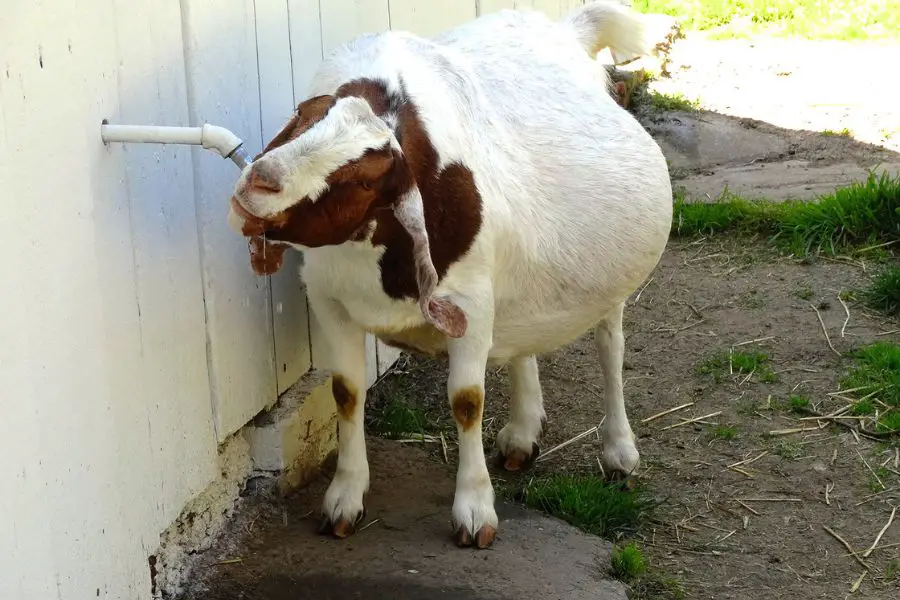Determining if your goat is pregnant is essential for the appropriate management. If the goat is pregnant, she will need extra food; if she is not pregnant, she will need to be bred again or investigated for pathology.
There are several methods to decide if a goat is pregnant, some more scientific than others.
Estrous Behavior Can Indicate Pregnancy
One of the simplest ways to detect if your goat is pregnant is to observe her behavior. If your goat fails to enter estrous (heat) after being mated with a buck, she may be pregnant.
Goats come into heat every fifteen to seventeen days, although some have a longer cycle. Tracking the goat's estrous cycle will allow the farmer to know when to expect his doe to return in season. Does are usually vocal and show obvious signs of flirting with the buck. If this behavior does not occur, the doe may be pregnant.
Some does can show apparent estrous behavior, even if they are pregnant, but it is usually less intense, and they do not stand to be bred by the buck.
Does with pathological condition such as hydrometra (fluid in the uterus due to a persistent corpus luteum) will not show estrous behavior. Hydrometra is common in goats and can confuse the outcome if the farmer only uses this method to determine pregnancy.
Goats not pregnant from late-season breeding will not show estrous behavior again until the following spring.
While it can be helpful to observe estrous behavior, it is not a foolproof method for determining pregnancy.
Change In Body Shape To Determine Pregnancy

Some people believe that observing changes to the shape of the goat's abdomen can indicate pregnancy. However, this is a very unreliable, subjective method and prone to error. In addition, it is often challenging to determine if the goat's abdomen changes when they are seen every day.
Goats with hydrometra will show the classic bulging belly of pregnant does, confusing the issue. Goats that have had multiple pregnancies have lax muscles and ligaments, making the stomach look bulging and pendulous. Detecting changes in the shape of these goats is not easy.
Maiden goats in their first pregnancy may not develop a pregnant shape until much later in gestation, resulting in misdiagnosis.
Goats that are pregnant usually have rounded shapes to their stomachs. When viewed from above, they have a tear-drop profile, with the rounded portion just in front of the hips.
Can Rectal Palpation Determine Pregnancy?
Rectal palpation is a common diagnostic pregnancy tool in horses and cows. Goats are much smaller, and it is difficult to complete rectal palpation accurately because the veterinarian or farmer's hand does not fit.
Some individuals claim that only the fingers can be used for palpation, but it is difficult, and inaccuracies commonly occur. It is possible that rectal palpation can cause miscarriage, making it a problematic method.
Development Of An Udder Indicates Pregnancy
Some farmers use Udder development to indicate pregnancy. If an udder has developed, this is the late stage of the pregnancy. The kids can be expected in one to six weeks.
Goats show different times for udder development. For example, some may develop an udder one week before birth, and some may be six weeks before delivery.
It can be tricky to determine udder development if the goat has just been dried off. The udder is still naturally enlarged and will have residual milk.
Using this method to determine if the goat is pregnant is not ideal. At this stage of pregnancy, it is too late to increase supplements and food to assist with the kids' growth. In addition, it can result in a malnourished goat with severe weight loss after birth.
Scientific Methods To Determine Pregnancy in Goats
There are several scientific methods to determine pregnancy in goats that are more reliable than the methods stated above.
Ultrasound Scans Can Determine Pregnancy In Goats
Ultrasound scanning equipment is portable, easy to use, and non-invasive. Ultrasound scans are safe for use on goats and give accurate results. Many veterinarians have ultrasound scanners as part of their standard equipment. Large goat farmers may prefer to purchase their own ultrasound scanners.
The scan may be done rectally or abdominally. Rectal scanning is usually used in pregnancies less than thirty days, and abdominal scans on goats more than thirty-five days pregnant.
Does that have been bred can be scanned to assess the reproductive status on a routine farm visit. Individual goats can be taken to the veterinary clinic for scanning if the farmer has a small herd or wishes to save costs.
Ultrasound scanning is a more expensive method of determining pregnancy. The reliability of ultrasound scans depends on the expertise of the user. An inexperienced individual may struggle to interpret the scan accurately.
Ultrasound scans are also useful for determining the number of kids the doe is carrying. This information takes the guesswork out of kidding, allowing the farmer to know when to intervene.
Pregnancy Tests For Goats
Various pregnancy tests have been developed for goats. They give an objective pregnancy assessment, resulting in a more accurate diagnosis.
Progesterone tests measure the goat’s progesterone levels in milk or serum. A low progesterone level confirms that a doe is not pregnant.
Other tests measure estrogen levels to determine if the goat is pregnant. Milk, serum, and urine samples are used for the test. Many of these tests are dipstick tests which are straightforward to use and interpret.
Hormone tests for pregnancy are cheaper than ultrasound scanning and do not require a veterinarian visit. Clear instructions make hormone tests viable options even for inexperienced farmers.
Waxy plugs on the goat's teats indicate that birth of the kids is near and the farmer should keep a close eye on the goat for signs of labor.
